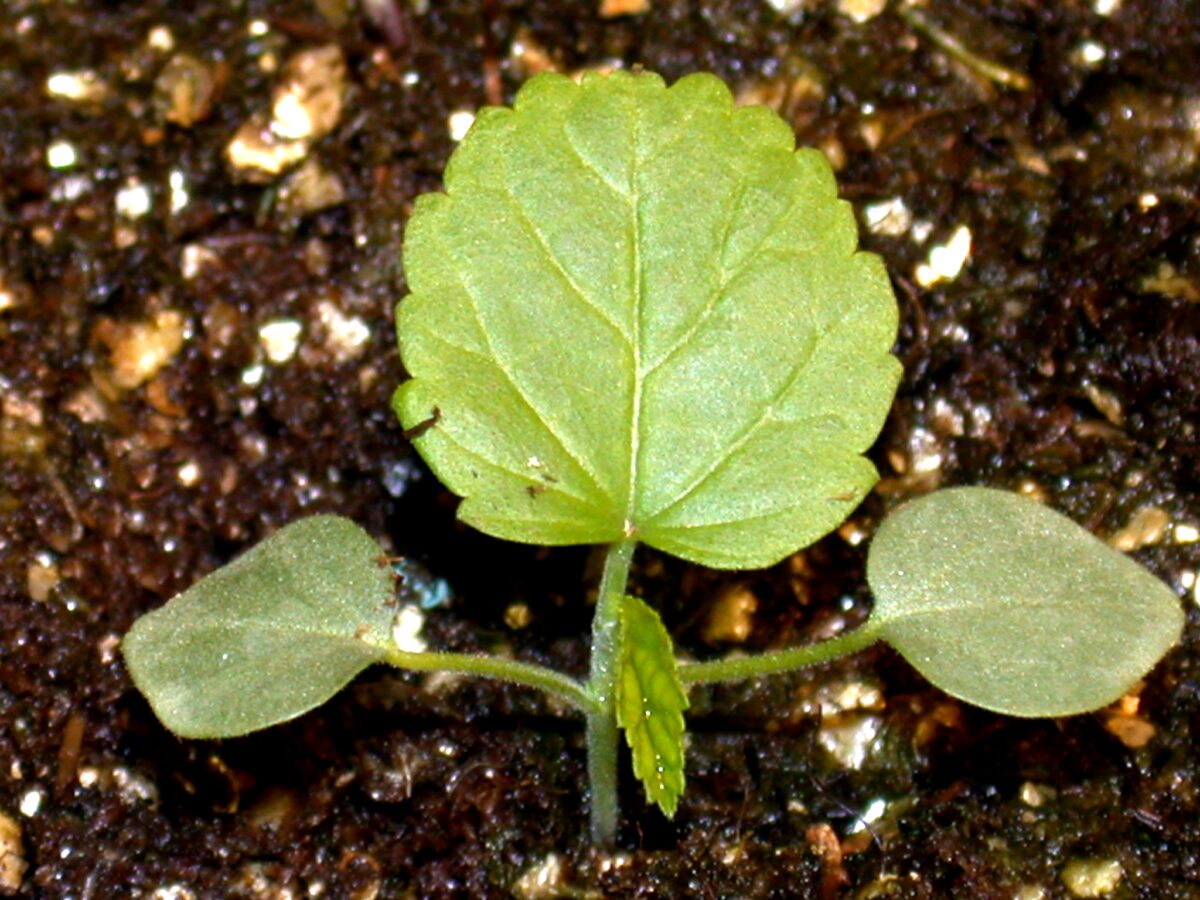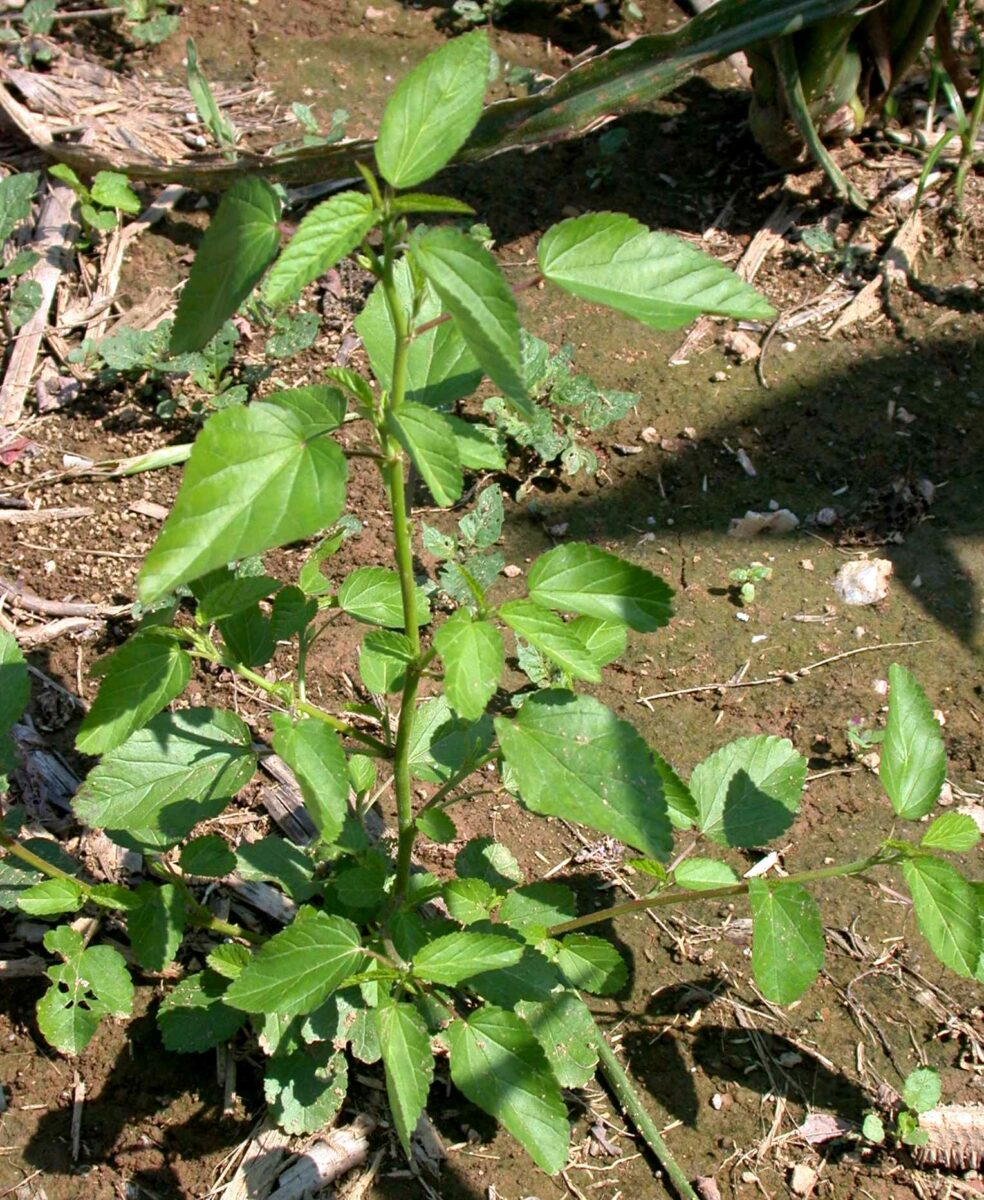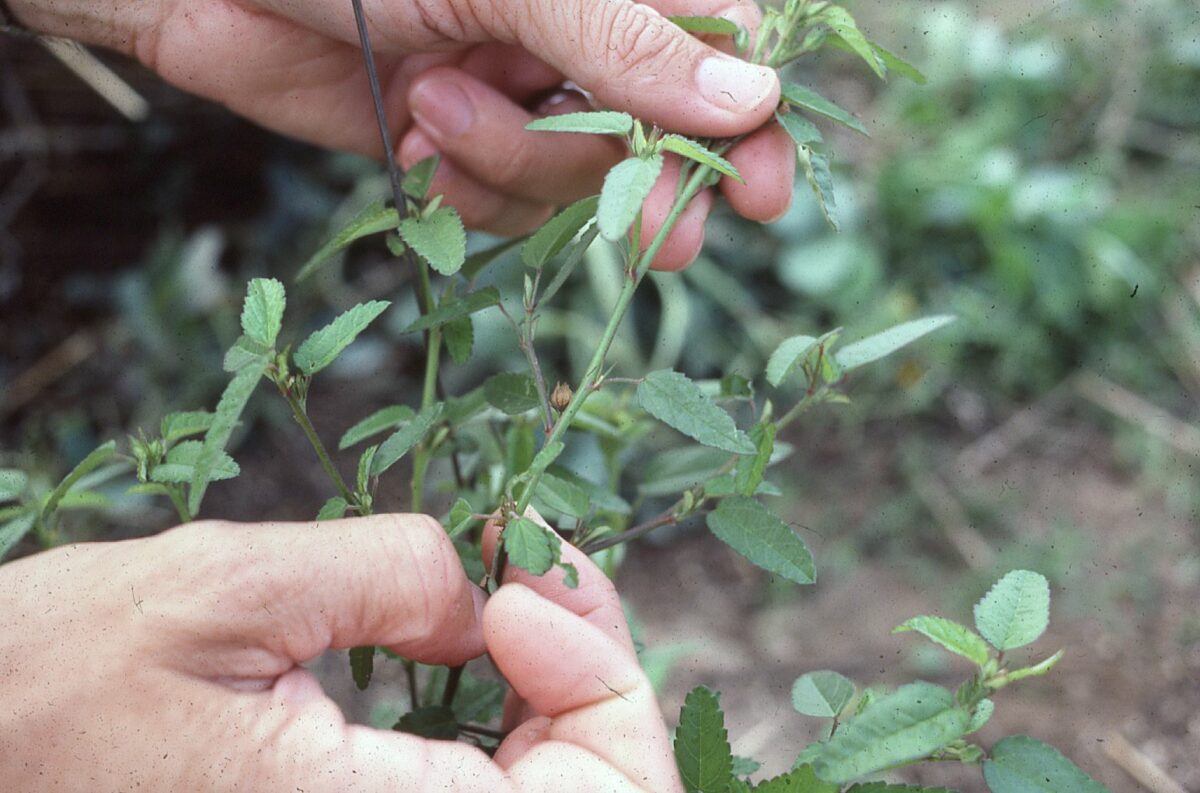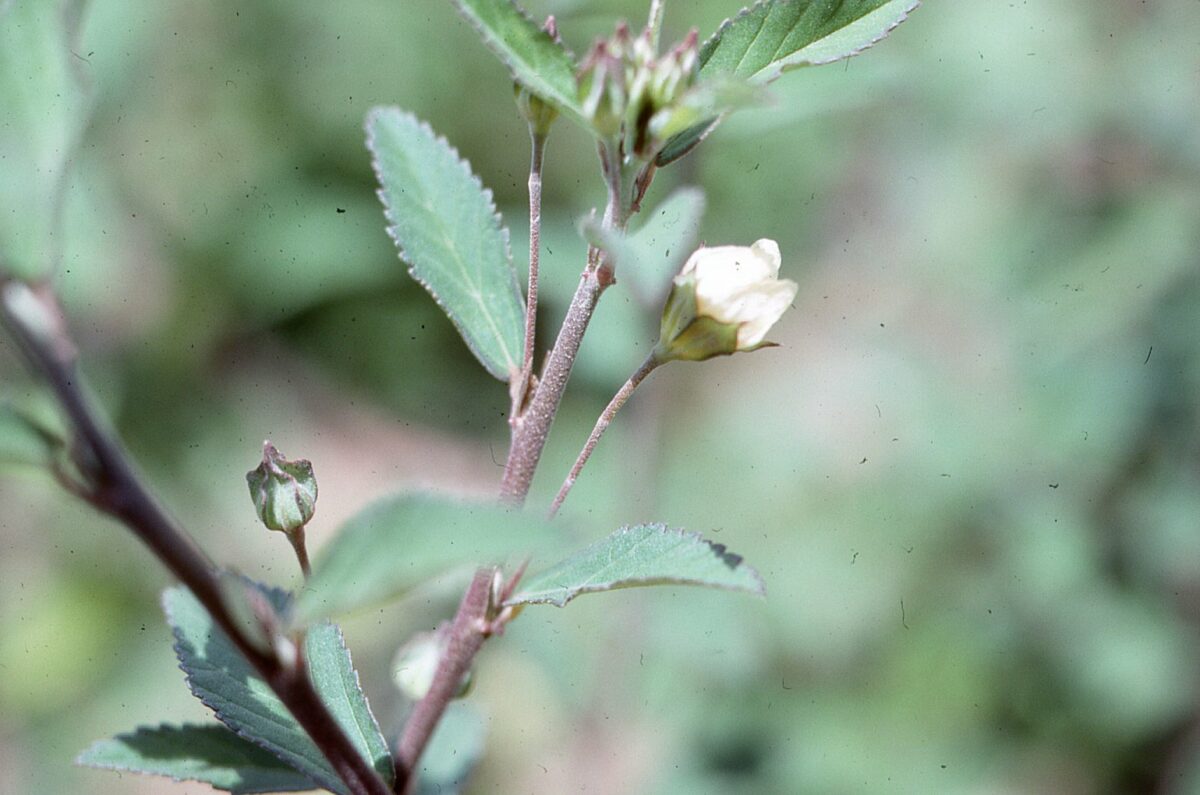Other common names: spiny sida, prickly mallow, false mallow, Indian mallow, thistle mallow, teaweed




Sida spinosa L.
Identification of Prickly Sida
Family: Mallow family, Malvaceae
Habit: In the temperate zone, it behaves as an upright summer annual; in tropical regions, it is a somewhat shrubby perennial.
Description: Seedlings have notched, round to heart-shaped, 0.3–0.6 inch-long by 0.2–0.3 inch-wide cotyledons. The first pair of true leaves is round, and subsequent leaves are oval to triangular. Long-stalked young leaves are alternate with toothed edges. The seedling stem, cotyledon edges and leaf edges are covered in short hairs. Mature plant stems are erect, highly branched, lightly hairy and can reach 0.7–3.3 feet in height. Leaves are alternate, 0.8–2 inches long by 0.4–0.8 inch wide, lanceolate to oval, toothed and have a 0.4–1.2 inch stalk; stipules are linear, and leaves may also have a 0.2–0.3 inch spine at the base. Leaf surfaces and stalks are covered with short hairs. The root system is a long, slender, branching taproot. Flowers are produced individually or clustered from leaf axils, on 0.08–0.5 inch stalks. Each flower has five pale yellow, 0.16–0.24 inch-long petals. Stamens are fused for most of their length, forming a column. Seeds are located in five-chambered capsules that split into five sections when mature; each section contains one seed and has two sharp spines at its apex. Seeds are 0.04–0.1 inch long and reddish brown, with two flat and one rounded side.
Similar species: Arrowleaf sida (Sida rhombifolia L.) leaf stalks are nearly absent and are much shorter than the flower stalks, whereas prickly sida leaf stalks are longer than the flower stalks. Virginia fanpettles [Sida hermaphrodita (L.) Rusby] can be distinguished from prickly sida by its white to pale pink flowers, lobed leaves and taller height (up to 10 feet) at maturity.
Management of Prickly Sida
Prickly sida emerges in late spring and summer and grows best in hot conditions. Consequently, it is a poor competitor and is easy to control in winter grains and cool season vegetables. Winter grains and early planted spring grains can be harvested before it goes to seed, thereby interrupting the life cycle. Because the seeds die off relatively quickly in the soil, rotation into hay for a few years can greatly decrease an infestation. Fall seedings of the hay can be timed to prevent reproduction during the establishment year. A spring seeding will require at least two carefully timed mowings: the first to catch the young prickly sida in the two- to four-leaf stage and the second a few days after the weed begins to flower, and an additional mowing may be required to prevent reproduction by late emerging plants.
Prickly sida is most troublesome in summer row crops like cotton, soybeans, corn and sorghum. Since prickly sida seeds die off relatively quickly and seeds must be close to the soil surface to successfully produce seedlings, populations will be easier to manage with annual moldboard plowing than with reduced tillage regimens. This should occur either in the spring or fall but not both, or some seeds will be plowed back up in the spring before they have had a chance to die off. Delaying soybean planting until mid-June will get the crop past the primary peak in prickly sida emergence. Tine weed as long as possible into the June emergence period. Cultivate shallowly to avoid bringing up new seeds into the near surface emergence zone. Flame weed cotton to destroy late emerging weeds in the crop row. Although close spacing of row crops can reduce light penetration and the growth of prickly sida, the benefits will rarely compensate for the reduced opportunities for cultivation. Prickly sida responds strongly to P fertility, so supply needed N with cover crops or plowed down sod, and minimize manure and compost use.
Prickly sida is among the species most susceptible to solarization. Covering soil with clear plastic for three weeks in mid-summer in Mississippi killed most seeds in the near-surface soil and reduced subsequent emergence by over 90%. The species can also be suppressed with straw mulch.
Ecology of Prickly Sida
Origin and distribution: Prickly sida is native to the United States. It occurs widely in the Southeast and Midwest, and sporadically in the Southwest and Northeast. It is widely distributed in tropical and subtropical regions.
Seed weight: 2.3 mg.
Dormancy and germination: Most newly matured seeds of prickly sida are dormant due to a water impermeable seed coat. Some newly matured seeds (15–32%), however, will germinate immediately at day/night temperatures of at least 86/59°F, with percentages increasing with temperature up to 104/77°F. Normally, water only enters the seed following weakening of cells in the region where the seed attached to the parent plant. Damage to the seed coat (scarification) also allows the seeds to take up water and results in nearly 100% germination over a wide range of temperatures. Aging intact seeds for 16 weeks in either continuously moist or alternating wet-dry conditions substantially increases germination to as much as 78% when seeds are subsequently germinated in a warm temperature regimen of 104/77°F. Similarly, storing the seeds dry at room temperature for three to nine months results in germination of 42–95%, with percentage germination increasing with the incubation temperature. Studies disagree on whether a few months of cold, moist conditions promote subsequent germination in warm conditions. Light does not promote germination. Seed germination is high at pH 5–8. In short, seeds become permeable and able to germinate after remaining in the soil for several months regardless of moisture conditions, and germination is most rapid and complete at warm temperatures. However, sustained temperatures of over 113°F kill seeds.
Seed longevity: Less than 1% of prickly sida seeds remained viable after 5.5 years of burial. From 22% to 27% of prickly sida seeds remained viable after 1.5 years of burial, giving an estimated annual mortality rate of 60%. When a sowing of prickly sida was tilled annually to various depths, the number of seeds declined by an average of 88% per year over a two-year period. Nevertheless, a few seedlings were still emerging after five years.
Season of emergence: In Kentucky and Mississippi, prickly sida emerges from April through September. Repeated counts through five seasons in Mississippi showed two peak periods of emergence, one in May and another in July–August.
Emergence depth: Emergence is poor at the soil surface, best from 0.2 inch and declines rapidly with greater depths. No seedlings emerge from deeper than 2 inches.
Photosynthetic pathway: C3
Sensitivity to frost: Prickly sida is sensitive to frost.
Drought tolerance: Prickly sida can maintain leaf function at higher water stress levels than other weeds and had the highest water-use efficiency compared to other C3 (but not C4) weeds.
Mycorrhiza: Prickly sida is mycorrhizal.
Response to fertility: Prickly sida is most commonly found on soils with high P, and it grew five-fold larger on soil testing high in P relative to soil testing very low. It grew 40% better on soil testing high in K than on soil testing low or medium. The species occurs most frequently on soils with a pH of 5.5–6.5, and growth is substantially reduced at pH of 5.2 or lower.
Soil physical requirements: The species is typically found on fertile loamy soil. It occurs most frequently on soils with low compaction and good internal drainage, but it tolerates poor drainage.
Response to shade: Prickly sida prefers full or partial sun. High density, narrow row cotton reduced light by 71–81% relative to normal planting but only reduced prickly sida growth by about half. In experiments with shade cloth, prickly sida produced highest growth and reproduction under mild shade (30–50%) and showed suppression only at a high (90%) shade level.
Sensitivity to disturbance: One mowing close to the ground between sorghum rows was sufficient to kill most plants and provided between-row control similar to a broadcast herbicide program. The species tolerates cattle grazing well.
Time from emergence to reproduction: In Illinois, plants flower from mid-summer to early fall. In Mississippi, flowering occurs from June until frost. Seeds become viable 12 days after flowering but continue to dry and develop a hard seed coat for another nine days before becoming ready for dispersal.
Pollination: Prickly sida is primarily self pollinated, and many flowers pollinate without ever opening. The flowers attract bees and butterflies, and it also outcrosses to a small extent.
Reproduction: Prickly sida produced 1,900 seeds per plant in full sunlight but 3,000 seeds per plant under the optimum 30% shade environment. However, it produced 8,100 seeds per plant when exposed to shade early followed by full sun later in the season, suggesting that it is especially adapted to reproduction during crop senescence.
Dispersal: Spines on segments of the seedpods can cling to fur or clothing and thereby distribute the seeds. Capsule segments float, so the species probably also disperses by water.
Common natural enemies: Three-cornered alfalfa hopper (Spissistilus festinus) feeds on prickly sida.
Palatability: Prickly sida has better digestibility than common southern forage grasses and has similar levels of crude protein, but it is deficient in P. Inclusion of some prickly sida in hay or silage still provides good animal nutrition. Its palatability is relatively low, however, as indicated by its increasing abundance in response to the intensity of cattle grazing.
Summary Table for Prickly Sida Characteristics
| Prickly Sida | ||||||||
|---|---|---|---|---|---|---|---|---|
| Growth habit | Seed weight (mg) | Seed dormancy at shedding | Factors breaking dormancy | Optimum temperature for germination (F) | Seed mortality in untilled soil (%/year) | Seed mortality in tilled soil (%/year) | Typical emergence season | Optimum emergence depth (inches) |
| short, branched | 2.3 | Yes | scd | 86-104 | 60 | 88 | mid-spring to summer | 0.2 |
| Photosynthesis type | Frost tolerance | Drought tolerance | Mycorrhiza | Response to nutrients | Emergence to flowering (weeks) | Flowering to viable seed (weeks) | Pollination | Typical & high seed production (seeds per plant) |
| C3 | low | moderate | yes | high | 8–12 | 2–3 | self, can cross | 2,000 & 8,000 |
Table Key
General: The designation “–” signifies that data is not available or the category is not applicable.
Growth habit: A two-word description; the first word indicates relative height (tall, medium, short, prostrate) and second word indicates degree of branching (erect, branching, vining).
Seed weight: Range of reported values in units of “mg per seed.”
Seed dormancy at shedding: “Yes” if most seeds are dormant when shed, “Variable” if dormancy is highly variable, “No” if most seeds are not dormant.
Factors breaking dormancy: The principle factors that are reported to break dormancy and facilitate germination. The order of listing does not imply order of importance. Abbreviations are:
scd = seed coat deterioration
cms = a period subjected to cold, moist soil conditions
wst = warm soil temperatures
li = light
at = alternating day-night temperatures
ni = nitrates
Optimum temperature range for germination: Temperature (Fahrenheit) range that provides for optimum germination of non-dormant seeds. Germination at lower percentages can occur outside of this range. The dash refers to temperature range, and the slash refers to alternating day/night temperature amplitudes.
Seed mortality in untilled soil: Range of mortality estimates (percentage of seed mortality in one year) for buried seeds in untilled soil. Values were chosen where possible for seeds placed at depths below the emergence depth for the species and left undisturbed until assessment. Mortality primarily represents seed deterioration in soil.
Seed mortality in tilled soil: Range of mortality estimates (percentage of seed mortality in one year) for seeds in tilled soil. Values were chosen for seeds placed within the tillage depth and subjected to at least annual tillage events. Seed losses are the result of dormancy-breaking cues induced by tillage, germination and deterioration of un-germinated seeds.
Typical emergence season: Time of year when most emergence occurs in the typical regions of occurrence for each weed. Some emergence may occur outside of this range.
Optimum emergence depth: Soil depths (in inches below the soil surface) from which most seedlings emerge. Lower rates of emergence usually will occur at depths just above or just below this range.
Photosynthesis type: Codes “C3” or “C4” refer to the metabolic pathway for fixing carbon dioxide during photosynthesis. Generally, C3 plants function better in cooler seasons or environments and C4 plants function better in warmer seasons or environments.
Frost tolerance: Relative tolerance of plants to freezing temperatures (high, moderate, low).
Drought tolerance: Relative tolerance of plants to drought (high, moderate, low).
Mycorrhiza: Presence of mycorrhizal fungi. “Yes” if present; “no” if documented not to be present, “unclear” if there are reports of both presence and absence; “variable” if the weed can function either with or without, depending on the soil environment.
Response to nutrients: Relative plant growth response to the nutrient content of soil, primarily N, P, K (high, moderate, low).
Emergence to flowering: Length of time (weeks) after emergence for plants to begin flowering given typical emergence in the region of occurrence. For species emerging in fall, “emergence to flowering” means time from resumption of growth in spring to first flowering.
Flowering to viable seed: Length of time (weeks) after flowering for seeds to become viable.
Pollination: “Self” refers to species that exclusively self-pollinate, “cross” refers to species that exclusively cross-pollinate, “self, can cross” refer to species that primarily self-pollinate, but also cross-pollinate at a low rate, and “both” refers to species that both self-pollinate and cross-pollinate at relatively similar rates.
Typical and high seed production potential: The first value is seed production (seeds per plant) under typical conditions with crop and weed competition. The second value, high seed production, refers to conditions of low density without crop competition. Numbers are rounded off to a magnitude that is representative of often highly variable reported values.
Further Reading
Baskin, J.M. and C.C. Baskin. 1984. Environmental conditions required for germination of prickly sida (Sida spinosa). Weed Science 32: 786–791.
Egley, G.H. and R.N. Paul, Jr. 1993. Detecting and overcoming water-impermeable barriers in prickly sida (Sida spinosa) seeds. Seed Science Research 3: 119–127.

